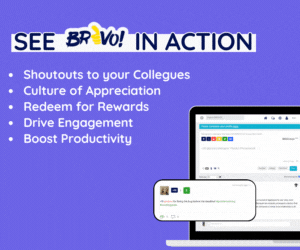
An employee experience framework is developed to make the tenure of the employees at a company positive. As for the employee experience, it is the journey of an employee in an organization.
The employee experience includes everything that an employee experiences while serving in a company. And it starts from their very first day to the day they leave or retire.
A study reveals that a positive employee experience is laid within the first month of an employee. Thus, the day of onboarding and the following days of learning about a company and its culture play an important role in this regard.
The positivity of the employee experience is, however, not limited to the beginning days only. It also includes factors such as career development opportunities, promotion over the years, etc.
An employee’s journey at an organization is also made positive with the culture of employee appreciation and recognition. So, any company with a culture of rewards and recognition is likely to develop a robust employee experience framework.
A company should not limit celebrating the professional lives of its employees only. So, it should also observe the positive happenings in their private lives. And this can include becoming parents, birthdays, anniversaries, and similar personal events.
After learning what employee experience entails, developing an employee experience becomes more effortless. And the better one grasps the concept of the employee journey, the more effective framework they can create.
This article discusses the top three anchors for your employee experience framework. These anchors can help a company develop a robust framework or make the existing one more effective.
Read them below:
What are the elements of employee experience?

Employee experience and employee engagement are two different concepts. The former is how satisfying the tenure of an employee has been in a company. On the other hand, the latter is the level of motivation and dedication one has towards their job.
The three main elements of employee relations are negotiation, consultation, and communication. In comparison, the three key elements of employee engagement are connection, appreciation, and meaning.
In addition, there also exists a difference between total employee experience and employee lifecycle.
The total employee experience takes into account all perceptions and experiences of an employee in a company. In contrast, the employee lifecycle represents the various stages of the employee-employer relation over the years.
The employee experience becomes positive when a company celebrates both the personal and professional moments of an employee. Therefore, one example of a moment that matters within an employee’s journey is getting a promotion (professional) and embracing parenthood (personal).
Employee experience is crucial because it makes the employees more productive and engaging, leading them to perform better.
1. Leadership voice/participation

It holds immense importance to include the leader’s voice and participation in the employee experience framework.
Suppose an employee on the first day of work receives a message from one of the executives, if not the chief executive. In that case, it lays the foundation of a positive employee experience.
When an employee receives a mere “We are pleased to have you onboard” message, their perception of the company becomes positive from the very beginning.
The positive involvement of the leaders in the employee’s journey helps to make them feel connected. It also helps to make the employees contribute to accomplishing the vision and mission of the company.
The voice of the leadership goes a long way in the employee experience. So, with the involvement of leadership, the perception built in the employees’ minds for the company is positive and humane. Resultantly, a close bonding, however professional, is created between the two.
There is another crucial role that leadership plays in making the employee experience positive.
How often the leaders acknowledge the employees for their hard work is one of the crucial factors that affect their experience. And while their voice and involvement are essential, their role in crediting the employees is equally significant.
Importantly, it is the responsibility of the managers to let the executives know if someone is burning the midnight oil for a company. Also, the leadership should be shared the precise details of an employee’s contribution so that the recognition could be more personalized.
Read More: How Employee Recognition Platform Motivates Your Workplace
2. Communicating information

An employee experience framework becomes robust and positive when a company communicates all the information with its employees.
A company should share with its employees all the developments that are taking place within the company. And if any action impacts their job, sharing the pertaining information becomes inevitable.
Some companies run a press release for sharing news on a particular development publicly. However, they neglect to share such information with its employees prior. So, often, the employees get to know about all the happenings through a public notice only.
When employees learn news on a change within the company from public notice, it is one thing. And being communicated the very information before it is shared with the general public is another.
When the employees are not intimated about the changes within the company, it gives them a feeling of alienation. Thus, from their productivity and performance to engagement and dedication, every factor on which a company thrives decreases.
When a company chooses not to disclose information with its employees, the employee experience within its workplace is badly impacted. Therefore, communication of such information is essential.
3. Don’t generalize

It is easier and tempting to use a single strategy in your employee experience framework. However, it may prove ineffectual, if not counterproductive. The reason is that each of your employees has an individual entity and character and thus different needs.
If something appeases one employee or a segment of employees, it may not satisfy the others. Therefore, to make your framework fruitful in making the employees’ journey positive, you may require going the extra mile. However, it pays off significantly, eventually.
Last few words
Developing an employee experience framework has become essential than ever. It is because most of the workforce today comprises the newer generation.
The new generation employees are not as complacent as the former generation of employees.
So, to take the most out and make the most of their potential, it is necessary to keep and make their overall experience positive.






